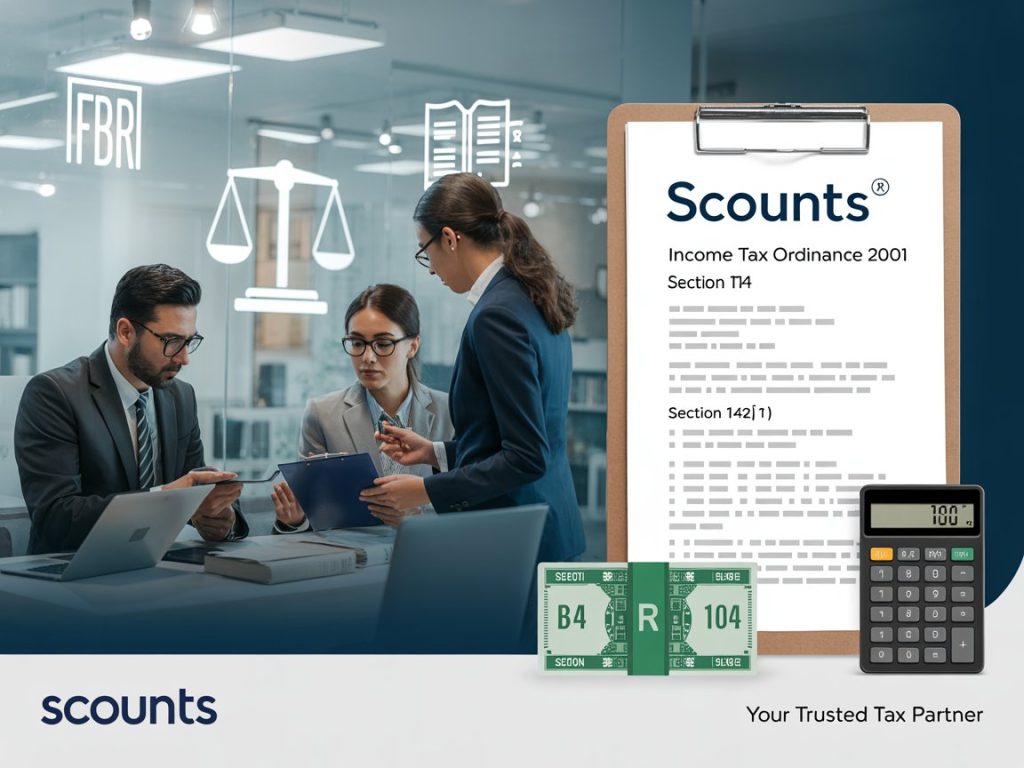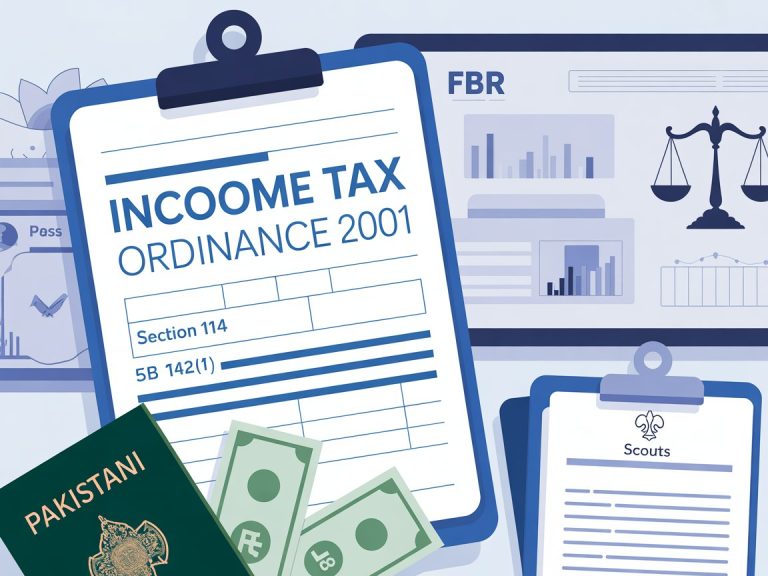Taxes are a big part of Pakistan’s economy, and the Income Tax Ordinance of 2001 is the basis for the country’s income tax laws. It’s important for everyone, whether you’re a person, a business owner, or a corporation, to understand this ordinance in order to follow the rules and plan your taxes well.
Our specialty at Scounts is offering small and medium-sized businesses end-to-end tax services, such as payroll, bookkeeping, direct and indirect tax filings, and NTN registration. We will examine the Income Tax Ordinance 2001, its main provisions, tax rates, compliance requirements, and how to respond to notices under Section 142(1) in this comprehensive guide, which is more than 2,500 words long.
📖 Tax Section Finder Tool
1. Introduction to the Income Tax Ordinance 2001
The main law governing income tax in Pakistan is the Income Tax Ordinance 2001. It brought a modernized tax structure with updated compliance mechanisms, penalties, and incentives, replacing the Income Tax Ordinance of 1979.
1.1 Objectives of the Income Tax Ordinance 2001
- standardize corporate, business, and individual tax laws.
- Increase revenue collection by broadening the tax base.
- To improve taxpayer compliance, streamline tax procedures.
- To guarantee equity, implement progressive taxation.
- Increased enforcement will help combat tax evasion.
1.2 Applicability of the Ordinance
The ordinance applies to:
✔ Resident individuals (earning income in Pakistan or abroad).
✔ Non-resident individuals (earning income in Pakistan).
✔ Association of Persons (AOPs) and companies.
✔ Foreign entities operating in Pakistan.

2. Income Tax Slabs & Rates in Pakistan (2023-2024)
Because Pakistan has a progressive tax system, those with higher incomes pay more in taxes. A thorough analysis of the current tax rates can be found below.
2.1 Tax Rates for Salaried Individuals
| Taxable Income (PKR) | Tax Rate (%) | Tax Amount (PKR) |
| Up to 600,000 | 0% | 0 |
| 600,001 – 1,200,000 | 2.5% | 15,000 |
| 1,200,001 – 2,400,000 | 12.5% | 150,000 + 12.5% of excess over 1.2M |
| 2,400,001 – 3,600,000 | 20% | 390,000 + 20% of excess over 2.4M |
| 3,600,001 – 6,000,000 | 25% | 750,000 + 25% of excess over 3.6M |
| 6,000,001 – 12,000,000 | 32.5% | 1,650,000 + 32.5% of excess over 6M |
| Above 12,000,000 | 35% | 3,750,000 + 35% of excess over 12M |
2.2 Tax Rates for Non-Salaried Individuals & AOPs
| Taxable Income (PKR) | Tax Rate (%) | Tax Amount (PKR) |
| Up to 400,000 | 0% | 0 |
| 400,001 – 600,000 | 5% | 10,000 |
| 600,001 – 1,200,000 | 10% | 40,000 + 10% of excess over 600K |
| 1,200,001 – 2,400,000 | 15% | 130,000 + 15% of excess over 1.2M |
| 2,400,001 – 3,000,000 | 20% | 310,000 + 20% of excess over 2.4M |
| 3,000,001 – 4,000,000 | 25% | 430,000 + 25% of excess over 3M |
| 4,000,001 – 6,000,000 | 30% | 680,000 + 30% of excess over 4M |
| Above 6,000,000 | 35% | 1,280,000 + 35% of excess over 6M |
2.3 Corporate Tax Rates
- Standard corporate tax rate: 29% (for tax year 2023-24)
- Banking companies: 35%
- Small companies (turnover < PKR 250M): 20%
- Export-oriented industries: Reduced rates (1-5%)
3. Key Sections of the Income Tax Ordinance 2001
The ordinance contains several critical sections that taxpayers must understand. Below is an in-depth analysis of the most relevant ones.
3.1 Section 114 – Filing of Income Tax Returns
- Who must file?
- Salaried individuals (if taxable income exceeds PKR 600,000).
- Businesses, AOPs, and companies.
- Deadlines:
- Salaried individuals: September 30
- Businesses & AOPs: December 31
- Penalties for late filing:
- PKR 1,000 per day (max PKR 50,000).
3.2 Section 148 – Powers of Tax Authorities
- Allows the FBR to:
- Conduct audits.
- Demand financial records.
- Issue notices for discrepancies.
- Non-compliance penalties:
- 10% of tax due (for late submission).
3.3 Section 182 – Advance Tax (Withholding Tax)
- Tax Deducted at Source (TDS) applies to:
- Salaries (if taxable).
- Contracts (6% for filers, 12% for non-filers).
- Services (8-15%).
- Bank withdrawals (0.3% for filers, 0.6% for non-filers).
3.4 Section 205 – Penalties for Tax Evasion
- Concealment of income: 25-50% of evaded tax.
- Fraudulent filings: 75% penalty + legal action.
4. Understanding Section 142(1) Income Tax Notice
If you receive a notice under Section 142(1), the FBR is requesting additional information about your tax return.
4.1 Why Did You Receive This Notice?
- Incomplete tax return (missing documents).
- Disparities between FBR records and declared income.
- Random audit selection.
4.2 How to Respond?
- Verify the notice via FBR’s IRIS portal.
- Submit required documents (bank statements, invoices, expense proofs).
- Seek expert help (Scounts can assist with response drafting).
4.3 The Results of Ignoring the Notice
- Best judgment calculation (your tax liability is estimated by FBR).
- Heavy penalties (up to 50% of tax due).
- Legal prosecution in severe cases.
5. Tax Planning & Compliance Strategies
5.1 How to Reduce Tax Liability Legally?
✔ Invest in tax-exempt plans (SSGC Bonds, Pension Funds, etc.).
✔ Make use of the permitted deductions (charitable contributions, medical costs).
✔ Return files on schedule to avoid fines.
5.2 Common Mistakes to Avoid
❌ Understating one’s income(leads to audits).
❌ Ignoring FBR notices (increases penalties).
❌ Late filing (additional fines apply).
6. How Scounts Can Assist with Tax Compliance
At Scounts, we provide comprehensive tax solutions, including:
✅ NTN Registration & Filing – Quick and hassle-free.
✅ Income Tax Return Filing – Accurate and timely submissions.
✅ Section 142(1) Notice Assistance – Expert handling of FBR queries.
✅ Payroll & Bookkeeping – Maintain compliant financial records.
✅ Tax Advisory – Legal ways to minimize tax liability.
Final Thoughts
All Pakistani taxpayers must abide by the complicated but crucial Income Tax Ordinance of 2001. To avoid fines, it is essential to comprehend tax slabs, filing requirements, and Section 142(1) notices.
Scounts is your go-to source for expert tax assistance! We guarantee smooth tax compliance so you can concentrate on expanding your company.

📞 Contact us today for expert tax solutions!
FAQs
Q1: What is the minimum taxable income in Pakistan?
- Salaried individuals: PKR 600,000
- Non-salaried individuals: PKR 400,000
Q2: How can I check my tax liability online?
- Use FBR’s Tax Calculator or log in to the IRIS portal.
Q3: What happens if I ignore a Section 142(1) notice?
- The FBR may issue an ex-parte assessment, leading to higher tax demands.
Q4: Can I revise my tax return after filing?
- Yes, under Section 114, revisions are allowed before the deadline.
For more guidance, trust Scounts – Your Reliable Tax Partner! 🚀

